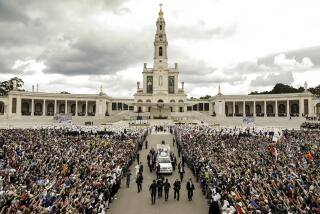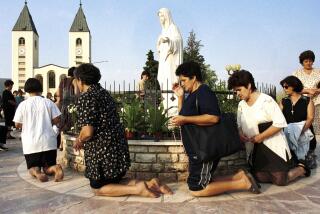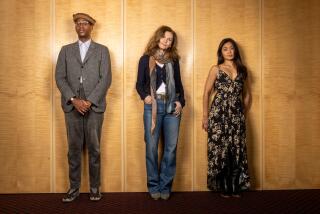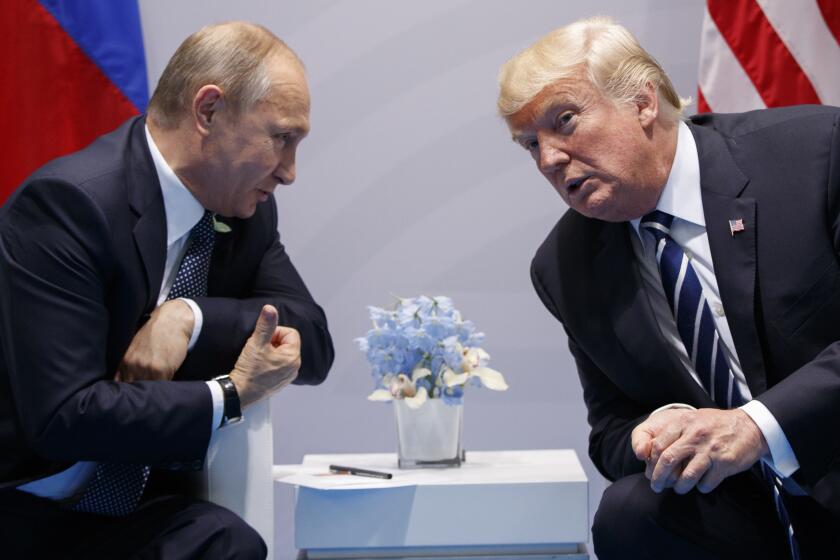Images of Mary Grow as Some Seek to Recast Her : Religion: Dissenters say her portrayal contributes to the oppression of women. Others focus on her strength.
- Share via
For nearly two millennia the Virgin Mary has been venerated as the exemplar of feminine perfection.
A holy enigma, she was both mother and virgin. She spoke with angels. She was the consort of God. Although meek and lowly, she was blessed among women as the mother of Jesus, the midwife of salvation, the new Eve in the new Eden.
Such is the picture of the perfect mother and woman painted by 2,000 years of church tradition and popular piety.
Now, however, some prominent church leaders are not only challenging the virgin birth, as others have for hundreds of years, but are arguing that the church’s Mary is a myth that contributes mightily to the oppression of women.
By making Mary sexless to correct the sin of Eve, some theologians charge, the church robs women of their power and substance.
“(Mary) entered the realm of the gods as one deprived of her humanity,” liberal Episcopal Bishop John Shelby Spong writes in a new book on the birth of Jesus. “She was a virgin bride, a virgin mother, a perpetual virgin, and a postpartum virgin. She was immaculately conceived at birth and bodily assumed at the moment of death. Clearly she was not a real woman.”
Others not only want to demythologize Mary but recast her image in various social causes.
In Guatemala, the mother of Jesus became a fulcrum for liberation theology’s social justice movement, compelling the government to ban the singing of the Song of Mary or the Magnificat (Luke 1:46-55) as subversive. In it Mary proclaims that God will bring down the mighty, raise up the lowly and feed the hungry.
In Chile and Argentina, Mary emerged as “Our Mother of the Disappeared” in solidarity with the families and victims of despotic governments that were reported to have kidnaped and executed political opponents. Today, the Catholic hymnal contains a hymn entitled “Madre del Desaparecido.”
Feminists, meanwhile, point to Marian passages in the Scriptures to illuminate a different side of Mary, one that is sympathetic to their cause. Mary’s declarations that the mighty will be deposed and the marginal empowered are not, they note, the words of a submissive woman. They believe that Mary embodies a deep reservoir of strength and determination that women today can tap. Some even choose to view Mary’s perpetual virginity as an ultimate statement of a liberated woman’s independence--an interpretation disputed by the Roman Catholic Church.
Others are focusing on Mary in the cause of Christian unity. In Culver City recently, 1,400 devotees packed Robert Frost Auditorium to listen to mystics and theologians talk about sightings of Mary and Jesus and Mary’s call for healing the divisions in Christendom.
“There are many images of Mary,” said Rosemary Radford Ruether, a Roman Catholic professor of theology at Garrett Evangelical Seminary in Evanston, Ill. “The Virgin of Guadalupe is not meek and mild. She’s the banner you carry in front of the ‘La Huelga (strike)’ sign in which farm workers’ challenge the planters,” said Ruether, who has written several books on Mary, including “Mary--The Feminine Face of the Church.”
Ronda Chervin, a philosophy professor at St. John’s Seminary in Camarillo, said: “Some people, I think quite wrongly, think of Mary as passive, maybe because of statues of her with her arms outstretched. She’s certainly not raising a fist! But I think that’s a great misunderstanding.”
Recasting Mary in the image of modern women has stirred strong disapproval from church conservatives. More than a few said “I told you so” after a lightning bolt struck York Cathedral in 1984 only days after a doubting Anglican priest was made a bishop in the medieval edifice. The prelate, the Rt. Rev. David Jenkins of the Church of England, had questioned the literal truth of the virgin birth and the Resurrection.
Traditional Catholics argue that Mary has not changed, but those who view her have. Moreover, they say Mary’s consent to bear Jesus was obedience to God, not to men.
“We should not try to recast Mary in terms of feminist or liberation theology,” said Father Johann G. Roten, director of the International Marian Research Institute at the University of Dayton in Ohio. Instead, he said any interpretation should be guided by sound theology and be scripturally based. “If that plays the way feminists want it to be played, fine. If that helps liberation theology, fine. But we are not recasting Mary to fit a feminist or liberation theological pattern.”
The divergence of theological and popular views on Mary comes at a time when the mother of Jesus is enjoying a resurgence in popularity and attention.
From Lourdes in France to Fatima in Portugal, tens of thousands of faithful are making pilgrimages to Marian shrines in a quest for healing and other miraculous interventions.
Reports of Marian apparitions and signs continue to inspire the faithful in places as far-flung as Medjugorje in the former Yugoslavia, Denver and Oxnard.
Many credit Mary with the fall of communism in Eastern Europe. Pope John Paul II has made devotion to Mary a central theme of his papacy, so much so that the letter M appears on his coat of arms.
During the past 40 years the Roman Catholic Church has acknowledged only 15 of hundreds of reported “appearances” of Mary during the 19th and 20th centuries, said Paul Ford, a theologian at St. John’s Seminary in Camarillo. Nonetheless, Ford and Roten said there is “no doubt” that reports of Marian apparitions are increasing.
For devout Catholics such as Pat Hoffman of Calabasas, Mary is above the tumult of politics. Mary is not only an object of veneration, but is experienced in profoundly joyous ways.
Hoffman said that before an experience at a Marian conference several years ago in Florida, she was a lapsed Catholic, one who thought Mary’s statues should be removed from churches. However, Hoffman--who works for a Catholic publication called Mary’s People--claims that during prayer a miracle happened: Her silver rosary chain turned to gold and Mary spoke to her.
“I have been touched deeply by our Blessed Mother. I’ve had a conversion of heart and to me that’s a miracle,” Hoffman said in an interview.
Why all the attention to Mary now? Several explanations are offered. Roten said Marian experiences are a reaction against impersonal, institutionalized religion as well as bureaucratic government. He also said that when tragedies such as war and famine threaten the social order, people turn to faith--in this case Mary--for solace and guidance. Others say that the upswing in reported appearances is caused by Mary herself because she is concerned about the turn of world events.
Another reason is the women’s movement. Heightened feminine consciousness causes people to view traditional stories of Mary in a new light, said Beverly Gaventa, associate professor of the New Testament at Princeton Theological Seminary.
“You read the story in Matthew where it said Joseph, being a good man, decided to divorce Mary in secret. . . . From a woman’s perspective, that doesn’t solve her problem. It means he will not . . . charge her with adultery, but she is still a very vulnerable person because she lives in a society wholly seen through the male perspective--and she’s about to have a baby,” Gaventa said.
In this case, an angel came to Joseph in a dream and urged him not to divorce because, through the action of the Holy Spirit, Mary was destined to bear a son who would save his people from their sins. Because of the angel’s intervention, Mary, instead of being shamed by the one who loved her, became revered.
Narratives of Jesus’ birth were not known to the first Christians. The Gospel of Mark--believed to be the oldest of the four Gospels--makes no mention of Jesus’ birth. The Apostle Paul, perhaps the greatest of Christian evangelists, assumed that Jesus’ birth was completely normal.
According to Spong, the Gospels of Matthew and Luke, which do mention the birth of Jesus, were written in the tradition of Jewish Midrash, in which a storyteller would often change details of an account, elaborate or borrow freely from Old Testament Scripture in order to convey a deeper truth. In the case of the virgin birth, the intent was to say something about the importance of Jesus, not Mary. Other gods and leaders were also said to have been born of virgins--from Adonis, a Babylonian deity, to Horus, a god of Egypt.
The Christian church lost its Jewish ties--and its understanding of the Midrash tradition--after the destruction of the temple in AD 70, and the old stories began to be viewed through Greek and Roman eyes as verifiable history. Moreover, a Greek philosophical mind-set was introduced: Bodies are evil, souls are good.
“As soon as that happened, the image of the Virgin entered into the minds of the Christian people of the one pure, person. You can almost watch the development from 100 AD to 150 AD. She arises as an ideal woman because she is a sexless, non-physical being,” Spong said.
“What I want to say to the churches,” Spong added, “is what is it about women that is so evil? It is that kind of attitude that has permeated Christianity for 2,000 years. Guilt and sex got inextricably tied up. . . . I think what has happened in the 20th Century is that the secular world has decided that guilt and sex need to be separated.”
In contrast to Jesus’ mother, the “other” woman in Jesus’ life, Mary Magdalene, proved to be too unconventional--and threatening--to the male view of an ordered universe, some theologians say.
Despite strong evidence in all four Gospel accounts that Magdalene played a central role in Jesus’ earthly ministry, to this day she remains popularly understood as a repentant prostitute, even though the New Testament makes no mention of it. Ruether said that if Magdalene had not been marginalized by church tradition, she “would have been a very different role model,” one that could have allowed traditionalists to envision women with apostolic authority.
Despite the challenges to such doctrines, the traditional image of Mary remains deeply ingrained in the social and cultural fabric of the Western world. As a consequence, say those espousing new views of Mary, women’s roles in the church have been limited.
Los Angeles Episcopal Bishop Frederick H. Borsch, a New Testament scholar, said that as long as Mary is denied her full humanity, including her sexuality, women will be restrained in the roles they can play in the church. “I think there are some real dangers . . . (in not allowing) the role of women to be all that it can in the church today,” he said.
But the Virgin Mary’s continued veneration throughout the world suggests that whether she is viewed as a champion of the lowly or the epitome of the obedient female, her appeal will endure.
“Mary has been a part of Christian faith for 2,000 years. To say the only way she will survive now is that she conforms to what we think is historically shortsighted in the extreme,” Gaventa said. “I think she will be around a long time after Bishop Spong and all the rest of us are silent.”
More to Read
Sign up for Essential California
The most important California stories and recommendations in your inbox every morning.
You may occasionally receive promotional content from the Los Angeles Times.










